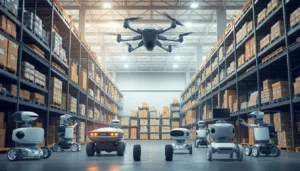In a world where robots are no longer just the stuff of sci-fi movies, automation robotics technology is transforming industries faster than you can say “Beep boop.” From manufacturing to healthcare, these clever machines are stepping in to take on tasks that were once reserved for humans, and honestly, they’re doing a pretty good job at it. Who wouldn’t want a tireless assistant that doesn’t need coffee breaks?
But it’s not just about replacing humans; it’s about enhancing productivity and efficiency. Imagine a factory where robots work side by side with humans, making the assembly line smoother and more efficient than ever. As automation continues to advance, it’s clear that this technology isn’t just a trend—it’s the future. Buckle up as we dive into the fascinating world of automation robotics and explore how it’s reshaping our lives one robot at a time.
Table of Contents
ToggleOverview of Automation Robotics Technology
Automation robotics technology integrates computer systems, machines, and software to perform tasks traditionally done by humans. The technology enables robots to execute functions with precision, enhancing productivity across various sectors. Recent advancements in artificial intelligence and machine learning allow robots to learn from experience, improving their efficiency and adaptability.
In manufacturing, robots undertake repetitive tasks such as assembly, welding, and packaging. By taking over these roles, they minimize human error and increase output rates. Data shows that companies utilizing automation robotics can achieve up to 30% higher production levels.
Robots also play a crucial role in logistics, where they manage inventory, sort packages, and handle shipping. Warehouses equipped with autonomous mobile robots can automate these processes, leading to significant cost reductions and faster delivery times.
Healthcare benefits greatly from automation robotics technology. Surgical robots assist surgeons in performing complex procedures with increased accuracy, resulting in quicker recovery times for patients. Additionally, robots help in rehabilitation, providing consistent therapy sessions tailored to individual patient needs.
On the consumer front, automation robotics technology appears in smart home devices. Devices like robotic vacuum cleaners and home assistants enhance daily living by taking over mundane household tasks. As reliance on these technologies grows, convenience and efficiency continue to improve.
The collaboration between humans and machines signifies a shift towards a future where tasks are divided based on strengths. While robots efficiently handle repetitive tasks, humans engage in more complex decision-making and creative processes. This partnership cultivates an environment ripe for innovation and progress across industries.
Key Components of Automation Robotics
Automation robotics relies on several crucial components that enhance its functionality. Understanding these components provides insight into how robotics technology operates in various settings.
Sensors and Actuators
Sensors detect physical phenomena such as temperature, pressure, and distance. They serve as the eyes and ears of robots, sending real-time data for processing. Actuators, on the other hand, convert that data into motion or action. By working together, sensors and actuators allow robots to interact with their environment effectively. For example, a robotic arm uses sensors to detect the position of an object and actuators to grasp it. This combination enhances precision in tasks, leading to higher efficiency. In manufacturing, up to 70% of tasks rely on these two components, highlighting their importance.
Control Systems
Control systems manage the operations of automation robotics. These systems process inputs from sensors and determine the appropriate actions through programmed algorithms. Various types of control systems exist, including open-loop and closed-loop systems. Open-loop systems execute commands without feedback, while closed-loop systems adjust actions based on real-time data. In practical applications, robots in warehouse settings utilize closed-loop systems to optimize inventory management. By constantly evaluating sensor input, they adapt to changes in their environment, improving overall effectiveness in processes.
Applications of Automation Robotics Technology
Automation robotics technology spans various sectors, enhancing efficiency and productivity across industries. This technology revolutionizes the way tasks are accomplished, with robots taking center stage in multiple applications.
Manufacturing and Industrial Uses
Automation robotics technology plays a vital role in manufacturing. Robots perform assembly tasks, operate machinery, and manage quality control, streamlining processes. Industry data shows that companies using automation experience a production increase of 30%. Flexible robotic systems allow for quick reconfiguration, adjusting to different product lines with ease. These advancements not only reduce labor costs but also minimize errors, ensuring higher quality outputs.
Healthcare Innovations
Robots significantly improve healthcare delivery. Surgical robots enable precision during complex operations, resulting in less invasive procedures and shorter recovery times. Advances in rehabilitation technology offer tailored therapy sessions, assisting patients in their recovery journeys. According to recent studies, surgical robots enhance accuracy, reducing the risk of complications by 20%. Automation in healthcare fosters collaboration between medical professionals and machines, ultimately improving patient outcomes.
Agriculture Advancements
Automation robotics technology transforms agriculture practices. Robots assist in planting, harvesting, and monitoring crops, increasing efficiency in food production. Precision farming techniques utilize drones and autonomous vehicles, enhancing yield while conserving resources. Statistics indicate that automation can boost crop production by 25% while lowering labor requirements. As farms adopt these technologies, they experience significant sustainability advancements, helping to address food security challenges.
Benefits of Implementing Automation Robotics
Implementing automation robotics yields significant advantages for various industries. Increased efficiency and cost reduction stand out as key benefits.
Increased Efficiency
Automation robotics enhances operational efficiency across multiple sectors. Robots perform repetitive tasks with precision, improving speed and consistency. Manufacturing operations experience production boosts of 30% due to these machines. Tasks like assembly and quality control become streamlined, enabling workers to focus on more complex and creative responsibilities. This transformation leads to faster turnaround times and higher output levels.
Cost Reduction
Cost reduction is another major benefit of implementing automation robotics. Businesses see significant savings by reducing labor costs, as robots take over tasks that would typically require multiple workers. Inventory management, shipping processes, and other logistical tasks witness improvements, leading to a decrease in overhead expenses. Companies often report a return on investment within just 12 months after adopting robotics technology. Faster processing times also accelerate cash flow, enabling businesses to allocate resources efficiently.
Challenges and Limitations
Automation robotics technology faces various challenges and limitations that must be addressed for continued growth. Technical limitations include issues with programming flexibility and the need for advanced maintenance. Sensors and software sometimes struggle to adapt to changing environments, which can hinder efficiency. These limitations affect reliability, especially in unpredictable settings.
Workforce impact represents another significant concern. Automation can lead to job displacement in sectors where repetitive tasks dominate, such as manufacturing. Employees might experience anxiety about job security as robots assume roles traditionally held by humans. However, automation also creates new opportunities, requiring a skilled workforce to manage, program, and maintain robotic systems. Industries need to focus on retraining workers to adapt to this evolving landscape and harness the benefits of collaboration between human and machine.
Future Trends in Automation Robotics Technology
Emerging trends in automation robotics technology point toward significant advancements. Enhanced artificial intelligence capabilities allow robots to process data faster and make decisions more efficiently. Integration of machine learning improves the adaptability of robots, enabling them to perform a broader range of tasks with minimal human intervention.
Robotics will increasingly collaborate with humans in various settings. Enhanced safety features in robotic systems will make them more reliable in environments where they interact closely with people. Companies will adopt collaborative robots, known as cobots, to complement human skills and support diverse tasks.
Development of smart robotics will emphasize connectivity. The Internet of Things (IoT) will allow robots to communicate with other devices, creating a more streamlined workflow in manufacturing and logistics. Centralized data management systems will enable real-time monitoring of robotic operations, improving process efficiency.
Sustainability initiatives will influence the future design and operation of robots. More manufacturers will focus on energy-efficient robots and sustainable materials. Robotics in agriculture will also advance, utilizing drones and automated systems to enhance farm productivity while reducing environmental impact.
In healthcare, robotic technology will continue to evolve rapidly. Innovations in telemedicine and remote surgery will expand access to healthcare services. Surgical robots will increasingly assist in complex procedures, driving further improvements in patient outcomes.
Lastly, workforce adaptation remains a crucial consideration. As automation becomes more prevalent, continuous training programs will ensure that workers acquire necessary skills to manage new technologies. Emphasis on reskilling will support a smooth transition for individuals affected by automation, fostering a balanced coexistence between human labor and robotics.
Automation robotics technology is reshaping industries by enhancing productivity and fostering collaboration between humans and machines. As robots take on repetitive tasks and assist in complex operations, they pave the way for innovation and efficiency. The integration of advanced AI and machine learning further empowers these systems, allowing them to adapt and improve over time.
While challenges like workforce displacement and technical limitations persist, the potential for new job opportunities and enhanced operational capabilities cannot be overlooked. As businesses continue to embrace automation, a focus on retraining and skill development will be crucial for a balanced future. The ongoing evolution of automation robotics promises to drive growth and sustainability across various sectors, making it an exciting field to watch in the years ahead.










